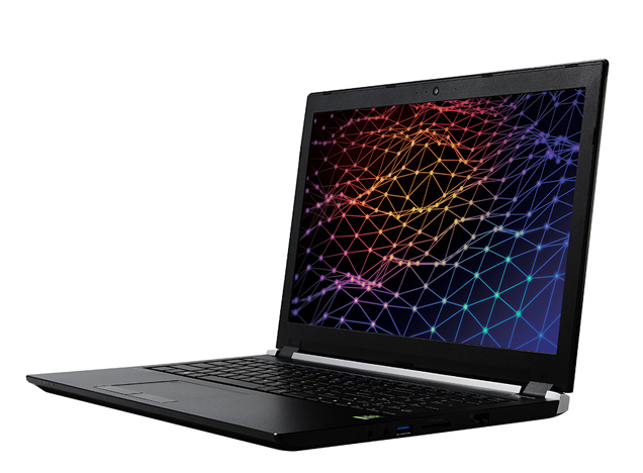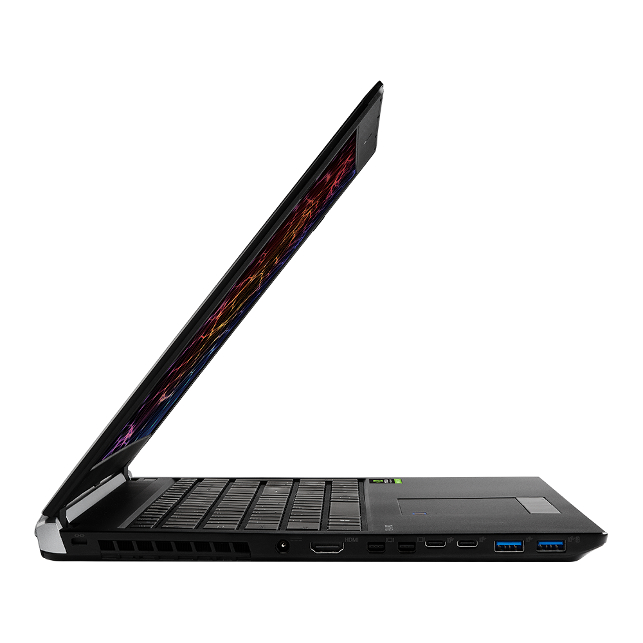PrevailPro P4000 – This slimline 15-inch mobile workstation breaks all the rules by putting the powerful ‘VR Ready’ Quadro P4000 GPU at its heart, writes Greg Corke
If you want a mainstream 15-inch mobile workstation from Dell, Fujitsu, HP or Lenovo, you can only choose between an entry-level or mid-range pro GPU, up to the CAD-focused Quadro M2200. But if you need something more powerful — for design viz, Virtual Reality (VR) or GPU rendering, for example — then you’ll need to invest in a 17-inch machine.

The trouble is, 17-inch mobile workstations are not that practical for designers who love to travel. While the weight of these models has come down considerably over the years, you still have to lug around a sizeable unit and a power supply that can weigh as much as a kilo. You also have to accept that the machine will probably have a shorter battery life.
Over the years we’ve seen a few specialist mobile workstation manufacturers offer more powerful GPUs in a 15-inch form factor — the names Eurocom, MSI and Schenker spring to mind. But it’s PNY’s new PrevailPro P4000 that’s really caught our attention.
PNY is no stranger to workstations. It has been Nvidia’s official Quadro GPU partner since 2002. But this is the first time it has released a mobile workstation of its own. And with the PrevailPro P4000 it’s making quite a statement.
As the name suggests, it offers the significantly more powerful Quadro P4000 GPU. What it doesn’t tell you is that it delivers it in an extremely slimline chassis. At only 18mm thick and weighing 2.18kg, The PrevailPro P4000 is thinner and lighter than the Quadro M2200/M2000 class HP ZBook 15 or Dell Precision 7510. In fact, it’s virtually in the territory of the ultra-portable Dell Precision 5520 or HP ZBook Studio, both of which feature the entry-level Quadro M1200M GPU.

The PNY PrevailPro P4000 is much slimmer than most VR Ready laptops
All of the mobile workstation mentioned above should be fine for 3D CAD, but the PNY PrevailPro P4000 gives you a very welcome boost for real time visualisation or GPU rendering. It also has the potential to take your designs into Virtual Reality (VR).
We say potential as, although the machine is branded ‘VR Ready’, it won’t have enough GPU power for all pro VR workflows. In addition, it’s important to note that the Quadro P4000 is a special 80W ‘Max Q’ design that is clocked slightly slower than the standard 100W Quadro P4000 found in 17-inch mobile workstations.
Regardless, this is a powerful GPU and to find out where its VR limits might lie, we tested with a couple of pro VR applications using an Oculus Rift. We achieved flicker free navigation with all of our Autodesk Revit Live datasets. In Autodesk VRED Professional, however, while it worked fine with small models it became unusable with larger automotive scenes or when antialiasing was turned on. However, we have found this to be the case with any Quadro P4000 GPU – desktop or mobile.

The machine features a slightly less powerful version of the Nvidia Quadro P4000 GPU
PrevailPro P4000 – product specifications
■ Intel Core i7-7700HQ 2.8GHz, 3.8GHz Turbo) (4 cores, 8 threads)
■ 32GB (2 x 16GB) DDR4 2,400MHz
■ Nvidia Quadro P4000 (8GB) (Max Q) (385.90)
■ 512GB M.2 NVMe SSD + 2TB 2.5-inch HDD
■ 15.6-inch IPS UHD (3,840 x 2,160)
■ 380 x 249 x 185mm 2.18kg
■ Microsoft Windows 10 Pro
■ 3 year Next Business Day on-site service
CPU benchmarks (single threaded) Seconds (smaller is better)
SolidWorks 2015 IGES export (single threaded): 111
CPU benchmarks (single threaded) Seconds (smaller is better)
Luxion KeyShot 6.1 render test (multi threaded): 828
V-Ray render benchmark (CPU) (multi threaded): 188
GPU compute benchmark Seconds (smaller is better)
V-Ray render benchmark (GPU): 121
3D graphics benchmarks (3D CAD) Score (bigger is better)
SPECapc for SolidWorks 2015 (shaded + edges): 4.27 (test run at 4K)
SPECapc for SolidWorks 2015 (RealView + shadows): 7.68 (test run at 4K)
SPECapc for SolidWorks (RealView + shadows + AO): 22.14 (test run at 4K)
SPECapc for PTC Creo 3.0 (shaded + edges): 7.32 (test run at 4K)
SPECapc for PTC Creo 3.0 (reflection): 11.5 (test run at 4K)
3D graphics benchmarks (design viz) Frames Per Second (FPS) (bigger is better)
LumenRT (hotel model) (FPS): 18 (test run at 4K)
LumenRT (roundabout model): 9 (test run at 4K)
Autodesk LIVE (Villa Enhanced model): 46 (test run at 4K)
Autodesk VRED Professional (AA off): 19 (test run at 4K)
Autodesk VRED Professional (AA medium):11 (test run at 4K)
Autodesk VRED Professional (AA ultra high ): 4 (test run at 4K)
3D graphics benchmarks (VR) Frames Per Second (FPS) (bigger is better)
VR Mark (Orange): 139.04 (VR resolution
VR Mark (Blue): 25.86 (VR resolution)
VR Mark (Cyan): 60.00 (VR resolution)







